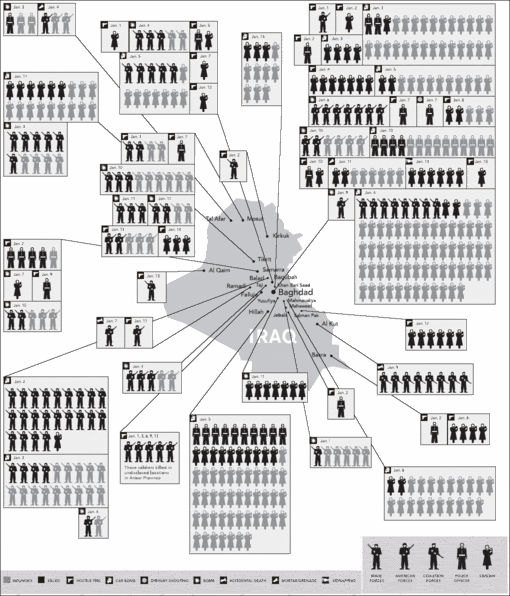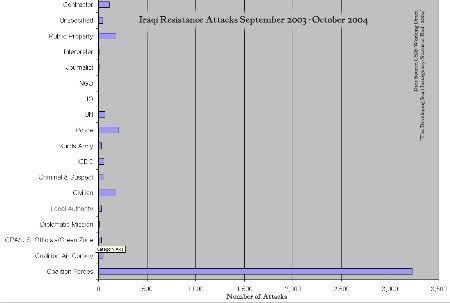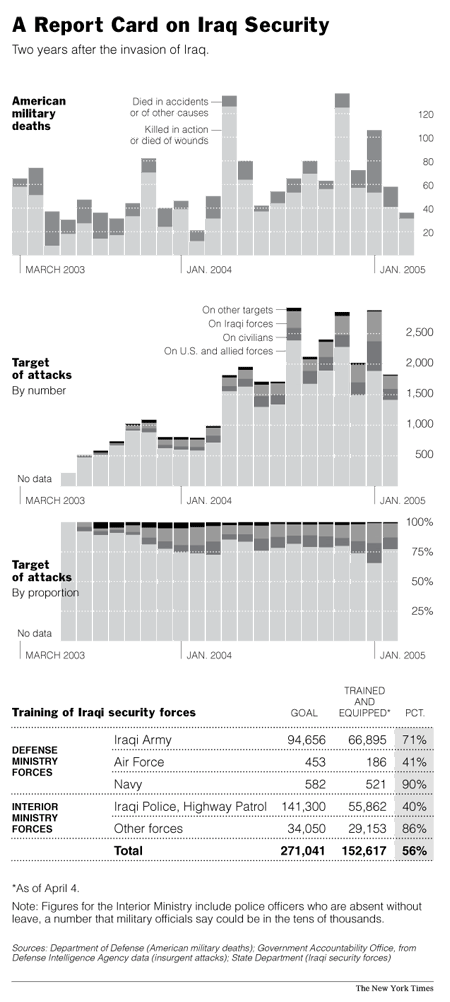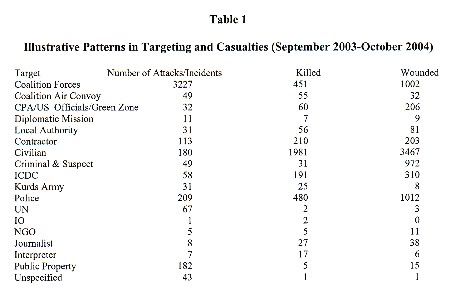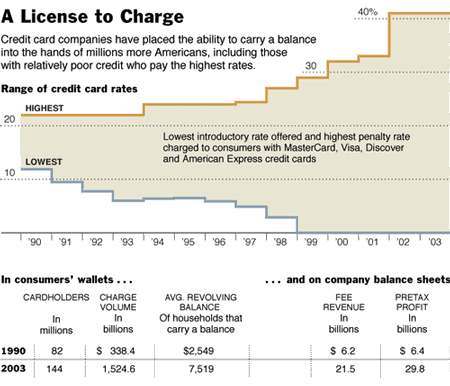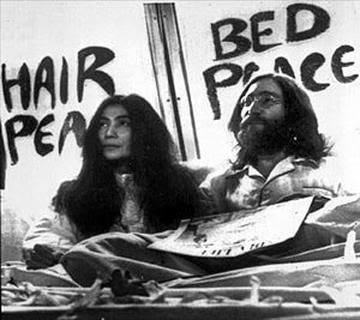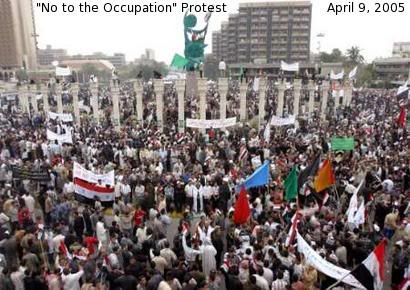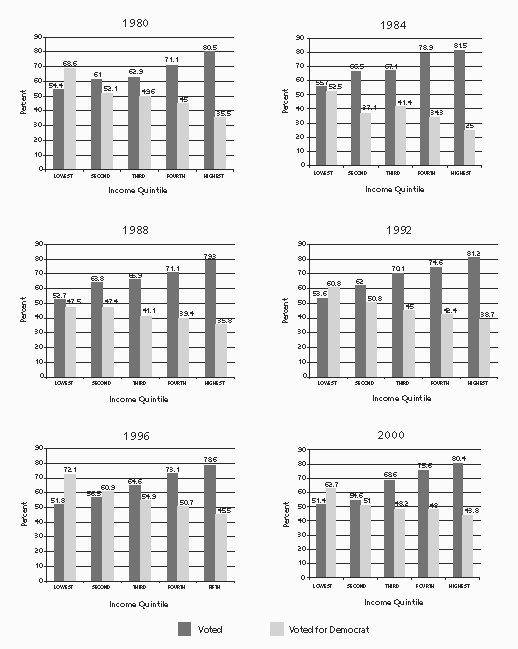Thursday, April 28, 2005
Reza Alavi, "New Flag of Iraq"
Reza Alavi's "New Flag of Iraq" (2003), the winner of the first prize of the Eighth Tehran International Poster Biennial (14-15 Feb. 2004):
Wednesday, April 27, 2005
Prices of Sex and Drugs
Stigma and illegality raise prices of commodified recreational sex and drugs higher, by decreasing their supply, than in a hypothetical free market in them, because there are more stigmas and legal penalties attached to sellers than buyers in most cases (the exception being adult men who buy sexual service of underage boys, unless they do so overseas). The irony is that moralists who disapprove of drug use and sex work do more to make the sex and drug industries profitable than libertarians who would treat them just like any other commodity.
Tuesday, April 26, 2005
Colleges and Universities as Working-class Institutions
Have American leftists fully grasped the implications of the changed relation between the working class and post-secondary education in the United States?
(The fancy word "academia," whether used to venerate or disparage post-secondary education, doesn't quite capture its reality in the United States, as the first two years of instruction at four-year colleges and universities as well as community college education function not unlike remedial classes for deficient high school education.)
A majority of American workers today experience post-secondary education. "More than half the U.S. population 25 and over in 2000 (52 percent) had completed at least some college education" (emphasis added, US Census Bureau, "Educational Attainment: 2000," August 2003). The younger workers are, the more likely they are to have college experience: "The rate of completion of some college was 58 percent among those in the 25- to 29-year age group" (emphasis added, US Census Bureau, August 2003). That's a momentous change since the 1930s and even the 1960s, two upsurges of class struggle in the United States (as well as the rest of the world).
Given the change, it's time to consider colleges and universities as working-class institutions rather than elite redoubts, without however putting blue-collar workers who have no college education (some of whom work on campuses as janitors, food workers, clerical workers, etc., colleges and universities being main employers in many cities and towns in America) on the political back burner. Because of the declining weight of mass production factories in the US economy (reflected in the big US trade and current account deficits), colleges and universities -- along with elementary, middle, and high schools -- are among the few remaining institutions where you can still find working-class youths en masse.
It's still important to organize workers at points of production, but the points of production have become increasingly fragmented (due for instance to the rise of mini mills, deregulation, outsourcing, offshoring, etc.), so it's more crucial than ever to organize workers at other working-class institutions such as schools as well as in working-class neighborhoods (in the form of community organizing).
(The fancy word "academia," whether used to venerate or disparage post-secondary education, doesn't quite capture its reality in the United States, as the first two years of instruction at four-year colleges and universities as well as community college education function not unlike remedial classes for deficient high school education.)
A majority of American workers today experience post-secondary education. "More than half the U.S. population 25 and over in 2000 (52 percent) had completed at least some college education" (emphasis added, US Census Bureau, "Educational Attainment: 2000," August 2003). The younger workers are, the more likely they are to have college experience: "The rate of completion of some college was 58 percent among those in the 25- to 29-year age group" (emphasis added, US Census Bureau, August 2003). That's a momentous change since the 1930s and even the 1960s, two upsurges of class struggle in the United States (as well as the rest of the world).
Given the change, it's time to consider colleges and universities as working-class institutions rather than elite redoubts, without however putting blue-collar workers who have no college education (some of whom work on campuses as janitors, food workers, clerical workers, etc., colleges and universities being main employers in many cities and towns in America) on the political back burner. Because of the declining weight of mass production factories in the US economy (reflected in the big US trade and current account deficits), colleges and universities -- along with elementary, middle, and high schools -- are among the few remaining institutions where you can still find working-class youths en masse.
It's still important to organize workers at points of production, but the points of production have become increasingly fragmented (due for instance to the rise of mini mills, deregulation, outsourcing, offshoring, etc.), so it's more crucial than ever to organize workers at other working-class institutions such as schools as well as in working-class neighborhoods (in the form of community organizing).
Monday, April 25, 2005
Retrofitting Style for the Net
Some styles of writing are more suitable for the Net than others. Which prose stylists of the past might serve as models of writing for the Net?
Men and women of letters in the age of Enlightenment: Pierre Bayle, Denis Diderot, Voltaire, and Lady Mary Wortley Montagu among others. Their voice was personal, their vision encyclopedic, and their spirit comparative and egalitarian (rather than historicist and hierarchical in the dominant fashion of the nineteenth century).
Socialist modernists of the twentieth century. Walter Benjamin and Roland Barthes, above all. (Theodor Adorno, on the strength of Minima Moralia, ought to be included, except that, had he lived in the era of the Net, he would have refused to blog, on the grounds that the word "blog" is unbearably ugly.)
Sei Shonagon, who wrote Makura no Soshi [The Pillow Book], a list of lists of things that she, a woman of ready wits and peremptory judgements, loved and hated, interspersed with her observations on court intrigues* and natural wonders. No other woman had a higher opinion of herself than Sei Shonagon in the history of world literature. She is the Ur-blogger.
* "The house of an official who receives no promotion in the New Year lists. Assuming that this would be the year, all of his friends and acquaintances, some even who have been posted to remote areas, gather at his house, crowding the courtyard with their carriage harnesses, coming and going, eating and drinking and making merry. But, even at dawn, there has still not been the knock at the gate announcing the promotion. Everyone pricks up his ears, listening for a signal, until finally one hears the voices of the runners announcing that the senior officials have left the palace with their announcements. One of the poor fellows sent out the previous evening to be the first to hear, returns to the house, shaking with the cold and obviously dejected. No one dares to ask. And when an outsider does ask what has transpired, the house answers simply that he has been named the Governor of so-and-so Province. Those who were counting on this promotion for their own ends are quite chagrined. And so morning comes, and quietly, one by one, the entourage slips away. Those bosom friends who can not make their exit as easily as this, count on their fingers the number of Provincial appointments that will come up for grabs in the following year’s lists, ambling listlessly about. All of this is so sad and depressing!" -- Sei Shonagon, Makura no Soshi
Men and women of letters in the age of Enlightenment: Pierre Bayle, Denis Diderot, Voltaire, and Lady Mary Wortley Montagu among others. Their voice was personal, their vision encyclopedic, and their spirit comparative and egalitarian (rather than historicist and hierarchical in the dominant fashion of the nineteenth century).
Socialist modernists of the twentieth century. Walter Benjamin and Roland Barthes, above all. (Theodor Adorno, on the strength of Minima Moralia, ought to be included, except that, had he lived in the era of the Net, he would have refused to blog, on the grounds that the word "blog" is unbearably ugly.)
Sei Shonagon, who wrote Makura no Soshi [The Pillow Book], a list of lists of things that she, a woman of ready wits and peremptory judgements, loved and hated, interspersed with her observations on court intrigues* and natural wonders. No other woman had a higher opinion of herself than Sei Shonagon in the history of world literature. She is the Ur-blogger.
* "The house of an official who receives no promotion in the New Year lists. Assuming that this would be the year, all of his friends and acquaintances, some even who have been posted to remote areas, gather at his house, crowding the courtyard with their carriage harnesses, coming and going, eating and drinking and making merry. But, even at dawn, there has still not been the knock at the gate announcing the promotion. Everyone pricks up his ears, listening for a signal, until finally one hears the voices of the runners announcing that the senior officials have left the palace with their announcements. One of the poor fellows sent out the previous evening to be the first to hear, returns to the house, shaking with the cold and obviously dejected. No one dares to ask. And when an outsider does ask what has transpired, the house answers simply that he has been named the Governor of so-and-so Province. Those who were counting on this promotion for their own ends are quite chagrined. And so morning comes, and quietly, one by one, the entourage slips away. Those bosom friends who can not make their exit as easily as this, count on their fingers the number of Provincial appointments that will come up for grabs in the following year’s lists, ambling listlessly about. All of this is so sad and depressing!" -- Sei Shonagon, Makura no Soshi
Sunday, April 24, 2005
Cao Zhenglu, Na Er
China Study Group has undertaken an ambitious project: translation of Na Er, a new Chinese novel by Cao Zhenglu (originally published in Dang Dai 5, 2004). Contribute to it if you can read Chinese. The novel, a critical examination of "effects of two decades of reform on urban workers" in China, presents a tough conundrum to translators, as its title as well as several key sentences in it turns on a pun in Chinese: "'Na er,' literally meaning 'there', is a mispronunciation of 'ying te na xiong nai er' (internationale) by the grandmother in the story" (China Study Group, "Calling for Translators"). "Na er" also means "where." The dream of international solidarity of the working class -- where is it to be found in China today?
Saturday, April 23, 2005
Andre Gunder Frank, 1929-2005
Andre Gunder Frank, an engaged intellectual who made lasting contributions to critical analysis of the political economy of imperialism, died today. His sons, Paul and Miguel, wrote to us who knew him:
He fought cancer with great courage, and was still working until two weeks ago, though in recent weeks he worked fewer and fewer hours every day because of pain and exhaustion. He worked with more strength and determination than we have the words to tell -- until his body gave up.Many of Frank's works are collected at rrojasdatabank.info/agfrank/. Read them and learn from them -- he wrote for you.
"Casualties of Colonial Wars" Republished in Seven Oaks Magazine
My blog entry "Casualties of Colonial Wars: Kenya and Iraq" (17 Apr. 2005) has been republished in Seven Oaks Magazine: "Casualties of Colonial Wars, from Kenya to Iraq" (22 Apr. 2005).
Friday, April 22, 2005
"For Good Luck in the Year of Rooster. . . ."
A found object on the Net, courtesy of Au Lait:
This animation and others like it, moreover, give a lie to the notion that Chinese (as well as other Asian) protests against Tokyo are generated by the government. The protests, instead, are a testament to the democratic power of viral communication.
According to Xiao Qiang of the China Digital Times, this is "one of many anti-Japanese animations circulating among young Chinese netizens recently" ("Anti-Japanese Animation in Chinese Cyberspace," 7 Apr. 2005). The animation doesn't convey a sophisticated political criticism -- it is, rather, a measure of raw anger with the history of Japanese imperialism and Tokyo's continuing refusal to take responsibility for it, rekindled by Tokyo's ambition to gain a permanent seat on the United Nations Security Council.
This animation and others like it, moreover, give a lie to the notion that Chinese (as well as other Asian) protests against Tokyo are generated by the government. The protests, instead, are a testament to the democratic power of viral communication.
Thursday, April 21, 2005
Privatizing a Mass Grave in Cambodia
From Rob Maguire of Project Communis, we learn that "Cambodia has privatized a mass grave where thousands of former dictator Pol Pot's political enemies were killed, handing it over to a Japanese company to run as a memorial" ("'Killing Fields' Gravesite Privatized in Cambodia," CBC News 4 Apr. 2005).
What's the deal?
Some Japanese, like some Americans, often cluelessly ask, "Why do they hate us?" Most of "them" probably don't hate the Japanese people (nor the American people), but many have a very good reason or two to hate crimes and misdemeanors of Japanese corporations and the government that supports them (as well as US corporations and the government that supports them), which aren't even above making a deal like this (to say nothing of garden-variety capitalist exploitation).
What's the deal?
According to a contract signed on March 18, the new operator, JC Royal Co., is expected to "increase revenue for the state and develop and renovate the beauty of Choeung Ek killing fields." JC Royal is to pay the municipality of Phnom Penh $15,000 a year. In return, it will be allowed to jack up entrance fees, charging foreign visitors up to $3 instead of the current 50 cents. (Kevin Doyle, "The Revenue Fields," Time Asia Magazine 18 Apr. 2005)Globalsecurity.org says that Saddam Hussein's regime probably killed "300,000 or more people over 20 years" and that "the existence of more than 40" mass graves has been confirmed ("Mass Graves," 30 Oct. 2004). If mass graves left by one US-supported dictator in Cambodia are fair game for commodification and privatization, why not those left by another US-supported dictator in Iraq? Or so the Pentagon might think, as it already approved one theme park in Iraq last year, even while fighting its endless war in the country:
Capt. Nik Guran of the 2-320 Field Artillery Regiment, a "major unit" of the 101st Airborne Division stationed in the small Iraqi town of Hatra, inserted a copy of "The Exorcist" in a portable DVD player. As the film began, Guran had the weird realization he was sitting at the location where director William Friedkin shot the opening sequence of his 1973 horror classic.
"He recognized the sun temples," Friedkin recently told me by phone from Hollywood.
"And then the Army hatched this idea," Friedkin continued, "to turn the whole area into a tourist attraction and call it 'The Exorcist Experience.'"
. . . . . . . . . . . . . . . . . . . .
Breathing new fire into the old clichés that war is hell and love of money is the root of all evil, American G.I.s have found a way to wrest Western capitalism out of the Iraqi sands where part of Hollywood's most popular devil movie was filmed.
Granted $5,000 by the Army's Commanders Emergency Response Program, the soldiers hired unemployed Mosul University students as guides, created a parking lot, opened a police station and revamped a nearby hotel. The theme park, which is officially backed by the Pentagon, will be turned over to the Iraqis once it's operating. Admission will be $2 or $5 with a kabob lunch. ("Strange Find in Iraq," New York Daily News 25 Jan. 2005)
Wednesday, April 20, 2005
Hazaaron Khwaishen Aisi
Rohan Shivkumar of Anarchitect offers a tantalizing glimpse of a new Indian film: Hazaaron Khwaishen Aisi (Dir. Sudhir Mishra, 2003).
The film's title comes from a ghazal by Ghalib:
The film's title comes from a ghazal by Ghalib:
![]()
![]()
A thousand desires like these, each worth dying for
Many are filled, and yet as many remain.
Hazaaron Khwaishein Aisi is an unconventional triangle with no single hero dominating the narrative. It is an open-ended graph of shifting relationships between three friends, two men and a woman, and not a rigidly enclosed triangle of formulaic romance. Two abiding themes -- the play with time and the changing psychology of people over a given time -- surface in practically every film [Sudhir] Mishra has made and they come together with near perfection in Hazaaron Khwaishein Aisi. He uses his Masters in Psychology to flesh out characters conceived in the round, a novelistic trait that film-makers so often overlook in the pursuit of the perfect image for its own sake.Mishra, who has a banner of Che Guevara in his living room, says: "He [Che] had a dream, and every dream which talks of a better future inspires me" (qtd. in Mohammed Wajihuddin, "Join the Fight," Screen 20 Apr. 2005).
So, it is time to meet the three protagonists as they graduate from a prestigious Delhi college and get inextricably drawn into their closely observed lives. Siddharth Tyabji (Kay Kay) is the emblematic representative of secular elitism: obviously the son of liberal Leftists who married across the communal divide. His dilemma is typical of his class, afflicted by the peculiar predicament of bearing a Muslim surname but unable to speak good Urdu. No one is more aware of this existential irony than Siddharth himself. He is the idealist looking for a cause in the ideological vacuum of a Delhi polluted by politicking. This is a Delhi society where class and education count more than ethnicity and language.
Geeta Rao (Chitrangada Singh) is the brilliant daughter of an eminent scientist, who, for all his eminence, clings to his South Indian conservative ways. Geeta has this innate ability to live easily in many worlds, a seeming epitome of the high-achieving modern woman. From the Telugu-speaking orthodox home complete with an extended family to the trendy set she hangs out with, and then on to Oxford for higher studies and finally to a strife-worn Bihar village... she traverses them all in the course of an eventful life, driven by her singular passion: Siddharth.
If Siddharth is the love of Geeta's life, Siddharth is in love with his great cause: bringing revolution to the parched land and disenfranchised peasants of Bihar. He gives up the cultured ease of Delhi to join the naxalites. His gentle, scholarly father watches helplessly -- he cannot approve but neither can he forbid, for he understands Siddharth's commitment to his chosen cause for which he is willing to pay any price.
Watching this drama from the sidelines is Vikram Malhotra (Shiny Ahuja). If his friends inhabit a rarefied realm of passionate idealism, Vikram is the point of identification. He is himself and yet, everyman. He is the typical small-town boy, desperate to acquire the cosmopolitan sheen that comes so naturally to the elegant Geeta and sophisticated Siddharth. Vikram is in a hurry to distance himself from his father's legacy -- a small-time, small-town politician who retains his idealism for which the son has nothing but contempt.
But watching the political process at first hand has given Vikram an invaluable lesson: how to spot, then court and win the politico and the party that is calling the shots at the moment, but without burning his bridges to previous denizens of the corridors of power. From artful survivor to smooth operator with high connections to independent purveyor of power is the fascinatingly familiar trajectory that Vikram's career takes. He knows everybody and apparently, everybody knows him too -- the more important part of the power transaction. Vikram's transformation from uncertain small-time guy to the assured, if oily, power-player, is wryly funny and precise in finding the satirical target.
For all his pragmatic survival skills that make him somebody over the years, Vikram is desperately in love with Geeta. And how this love stays with him -- even after Geeta returns from Oxford, becomes a journalist and endures an unhappy marriage and finally, throws in her lot with Siddharth, a man hunted by the police -- is Vikram's path to redemption. He is jealous of Siddharth at one level, specially when he finds out that Geeta has been using her journalistic cover to meet the fugitive activist and has an off-and-on affair with him. At another level, Vikram has a reluctant admiration for a man who has the courage of his convictions. When it comes to the crunch and Siddharth's life is in imminent danger, it is Vikram who uses his connections and comes to the aid of his one-time classmate and rival. (Maithili Rao "Mapping a Political Era," Frontline 22.5 26 Feb. -11 Mar. 2005)
Tuesday, April 19, 2005
Enjoy Your Zizek!
A new feature documentary exploring "the eccentric personality and esoteric work" of Slavoj Zizek is out: Zizek! (Dir. Astra Taylor, 2005). A preview will be held at the Roxy Theater in San Francisco on April 21, 2005.
Why go and see Zizek!"? For me, the number one reason to watch the film would be to learn how to subvert the hegemony of the Protestant work ethic from the prolific master who has perfected the Art of Laziness:
Why go and see Zizek!"? For me, the number one reason to watch the film would be to learn how to subvert the hegemony of the Protestant work ethic from the prolific master who has perfected the Art of Laziness:
"When people ask me why I don't teach permanently in the United States, I tell them that it is because American universities have this very strange, eccentric idea that you must work for your salary," Zizek says. "I prefer to do the opposite and not work for my salary!"Florida community college students and teachers who are inspired by Zizek's method of practicing and inculcating the Art of Laziness, however, are out of luck. The state of Florida, as if to caricature the bureaucratic ethos of industrial modernity, established (effective October 1982) a minimum word count requirement that each student must fulfill in order to obtain an associate in arts degree:
Zizek has developed an elaborate set of psychological tricks to manipulate his American students and enable him to have as little contact with them as possible. At the first meeting of each course, he announces that all students will get an A and should write a final paper only if they want to. "I terrorize them by creating a situation where they have no excuse for giving me a paper unless they think it is really good. This scares them so much, that out of forty students, I will get only a few papers," he says. "And I get away with this because they attribute it to my 'European eccentricity.'" (Robert Boynton, "Enjoy Your Zizek!" Lingua Franca Oct. 1998)
Gordon Rule Writing Requirement
The State of Florida requires that all students who receive an A.A. Degree must demonstrate competency in written communication through the satisfactory completion of 24,000 written words. The Gordon Rule Writing Requirement in Creative Arts and Humanities requires 1500 words of analytically graded writing in courses which are designated as providing Gordon Rule Credit. (Please refer to the 1999-2000 A.A. Degree General Education requirements.) Journals and exams, unless analytically graded, cannot be included in that total. Email communications cannot be counted as Gordon Rule writing. When an assignment has a word total range (i.e., 500-700 words), the department must count the lowest number when determining Gordon Rule words. (Santa Fe Community College - Gainesville, Florida, "Guidelines for Writing in Gordon Rule Classes")
Monday, April 18, 2005
Efficiency of Universal Access: Broadband and Health Care
Thomas Friedman frets that the Untied States is falling behind in economic competitiveness, especially due to its lagging investment in information infrastructure:
After all, who aside from telecom giants would benefit from their rent-seeking? What's good for AOL, SBC, Verizon, and the like isn't good for America, not even American capitalists as a whole.
In the same issue of the New York Times where Friedman lamented "an industrial-age presidency, catering to a pre-industrial ideological base, in a post-industrial era" (Friedman, 15 Apr. 2005), Paul Krugman had this to say about health care costs in the United States:
Large employers are indeed looking for a cheaper alternative to the status quo, but "[i]n considering new strategies, employers rely on their view that a market-driven system can best address the widely recognized inefficiency and suboptimal quality of our current health care system.2-4 They believe that the same approach that has worked in other parts of their business -- providing financial incentives to improve quality and lower costs -- can be adapted to health care" ("Large Employers' New Strategies in Health Care," New England Journal of Medicine 347.12, 19 Sep. 2002, p. 939). Apparently, either ideology gets in the way of seeing a proven solution that is staring US manufacturers in their face, or US manufacturers have concluded that, if all else fails, they can always offshore almost all jobs.
Universal access, whether in providing broadband or health care, is far more efficient than privatized access. Not only would it benefit workers and small businesses greatly; it would also achieve considerable cost savings for big corporations. Corporate America doesn't see it this way, though. The ruling class are evidently more class conscious than the working class in the United States, and capitalists who own and manage big corporations would rather exercise class solidarity with small factions of their class: those who own telecom giants in the case of broadband and those who own insurance companies and HMOs in the case of health care. Therefore, it falls to American workers to save themselves. If they do, they may, just as in the times of the Great Depression, ironically end up saving American capitalism from American capitalists.
Thomas Bleha, a former U.S. Foreign Service officer in Japan, has a fascinating piece in the May-June issue of Foreign Affairs that begins like this: "In the first three years of the Bush administration, the United States dropped from 4th to 13th place in global rankings of broadband Internet usage. Today, most U.S. homes can access only 'basic' broadband, among the slowest, most expensive and least reliable in the developed world, and the United States has fallen even further behind in mobile-phone-based Internet access. The lag is arguably the result of the Bush administration's failure to make a priority of developing these networks. In fact, the United States is the only industrialized state without an explicit national policy for promoting broadband."To say that the United States lacks "an explicit national policy for promoting broadband" (Bleha qtd. in Friedman, 15 Apr. 2005) understates the problem for Americans on the wrong side of the digital divide. A number of cities and towns are actually building cheaper alternatives to oligopolistic Internet Service Providers that charge monthly broadband fees of $50 and above, often choosing free wireless access like Dayton and Philadelphia. Communications giants, however, are doing all they can to block such public access efforts:
. . . In 2001, Japan was well behind the United States in the broadband race. But thanks to top-level political leadership and ambitious goals, it soon began to move ahead.
"By May 2003, a higher percentage of homes in Japan than the United States had broadband. . . .
"Today, nearly all Japanese have access to 'high-speed' broadband, with an average connection time 16 times faster than in the United States - for only about $22 a month. . . ." ("Bush Disarms, Unilaterally," New York Times 15 Apr. 2005)
You’ll be pleased to know that communism was defeated in Pennsylvania last year. Governor Ed Rendell signed into law a bill prohibiting the Reds in local government from offering free Wi-Fi throughout their municipalities. The action came after Philadelphia, where more than 50 percent of neighborhoods don’t have access to broadband, embarked on a $10 million wireless Internet project. City leaders had stepped in where the free market had failed. Of course, it’s a slippery slope from free Internet access to Karl Marx. So Rendell, the telecom industry’s latest toady, even while exempting the City of Brotherly Love, acted to spare Pennsylvania from this grave threat to its economic freedom.Legislation that prohibits public broadband access is pending in Colorado, Florida, Illinois, Iowa, Nebraska, Ohio, Oregon, Tennessee, and Texas. Indiana, however, defeated HB 1148, "championed by SBC Communication," which "would have prohibited Indiana cities and towns from providing municipal broadband services" ("Community Internet: Indiana" Freepress.net). That shows that media democracy activists have a fighting chance.
. . . . . . . . . . . . . . . . . . . .
. . . Pushed by lobbyists, at least 14 states have passed legislation similar to Pennsylvania's. I've always wondered what almost $1 billion spent on lobbying state lawmakers gets you. Now I'm beginning to see. (Lawrence Lessig, "Why Your Broadband Sucks," Wired 13.3 March 2005)
After all, who aside from telecom giants would benefit from their rent-seeking? What's good for AOL, SBC, Verizon, and the like isn't good for America, not even American capitalists as a whole.
In the same issue of the New York Times where Friedman lamented "an industrial-age presidency, catering to a pre-industrial ideological base, in a post-industrial era" (Friedman, 15 Apr. 2005), Paul Krugman had this to say about health care costs in the United States:
In 2002, the latest year for which comparable data are available, the United States spent $5,267 on health care for each man, woman and child in the population. Of this, $2,364, or 45 percent, was government spending, mainly on Medicare and Medicaid. Canada spent $2,931 per person, of which $2,048 came from the government. France spent $2,736 per person, of which $2,080 was government spending.Here are a few graphic illustrations that Woolhandler, Campbell, and Himmelstein provide:
Amazing, isn't it? U.S. health care is so expensive that our government spends more on health care than the governments of other advanced countries, even though the private sector pays a far higher share of the bills than anywhere else.
What do we get for all that money? Not much.
Most Americans probably don't know that we have substantially lower life-expectancy and higher infant-mortality figures than other advanced countries. It would be wrong to jump to the conclusion that this poor performance is entirely the result of a defective health care system; social factors, notably America's high poverty rate, surely play a role. Still, it seems puzzling that we spend so much, with so little return.
A 2003 study published in Health Affairs [22.3, May/June 2003] (one of whose authors is my Princeton colleague Uwe Reinhardt) tried to resolve that puzzle by comparing a number of measures of health services across the advanced world. What the authors found was that the United States scores high on high-tech services -- we have lots of M.R.I.'s -- but on more prosaic measures, like the number of doctors' visits and number of days spent in hospitals, America is only average, or even below average. There's also direct evidence that identical procedures cost far more in the U.S. than in other advanced countries.
The authors concluded that Americans spend far more on health care than their counterparts abroad -- but they don't actually receive more care. The title of their article? "It's the Prices, Stupid."
Why is the price of U.S. health care so high? One answer is doctors' salaries: although average wages in France and the United States are similar, American doctors are paid much more than their French counterparts. Another answer is that America's health care system drives a poor bargain with the pharmaceutical industry.
Above all, a large part of America's health care spending goes into paperwork. A 2003 study ["Costs of Health Care Administration in the United States and Canada" by Steffie Woolhandler, M.D., M.P.H., Terry Campbell, M.H.A., and David U. Himmelstein, M.D. ] in The New England Journal of Medicine [349.8, 21 Aug. 2003] estimated that administrative costs took 31 cents out of every dollar the United States spent on health care, compared with only 17 cents in Canada. (Paul Krugman, "The Medical Money Pit," New York Times 15 Apr. 2005)



("Costs of Health Care Administration in the United States and Canada," New England Journal of Medicine 349.8, 21 Aug. 2003)
General Motors Corp.'s bonds fell after the company failed to wrest any concessions from its largest trade union, adding to concern the world's biggest automaker won't be able to cut health-care costs.GM, as well as other US manufacturers, succeed in extracting big and small concessions from unionized workers from time to time, but privatized health care still puts them at a disadvantage when competing with corporations that have socialized the costs of their employees' health care. Shouldn't that motivate them to join hands with organized labor and advocate socialized medicine, which is bound to lower their health care bills dramatically even if they end up paying slightly higher taxes?
GM . . . agreed with the United Auto Workers union to stay within the bounds of their four-year contract as the company seeks to restrain health costs that have risen 33 percent in five years. The company's stock fell 6.5 percent to its lowest level since 1993 during trading in New York yesterday. (John Glover, "GM Bonds Plunge; Union Won't Reopen Health Contract [Update2]," Bloomberg.com 15 Apr. 2005)
Large employers are indeed looking for a cheaper alternative to the status quo, but "[i]n considering new strategies, employers rely on their view that a market-driven system can best address the widely recognized inefficiency and suboptimal quality of our current health care system.2-4 They believe that the same approach that has worked in other parts of their business -- providing financial incentives to improve quality and lower costs -- can be adapted to health care" ("Large Employers' New Strategies in Health Care," New England Journal of Medicine 347.12, 19 Sep. 2002, p. 939). Apparently, either ideology gets in the way of seeing a proven solution that is staring US manufacturers in their face, or US manufacturers have concluded that, if all else fails, they can always offshore almost all jobs.
Universal access, whether in providing broadband or health care, is far more efficient than privatized access. Not only would it benefit workers and small businesses greatly; it would also achieve considerable cost savings for big corporations. Corporate America doesn't see it this way, though. The ruling class are evidently more class conscious than the working class in the United States, and capitalists who own and manage big corporations would rather exercise class solidarity with small factions of their class: those who own telecom giants in the case of broadband and those who own insurance companies and HMOs in the case of health care. Therefore, it falls to American workers to save themselves. If they do, they may, just as in the times of the Great Depression, ironically end up saving American capitalism from American capitalists.
Sunday, April 17, 2005
Casualties of Colonial Wars: Kenya and Iraq
To justify its continuing occupation of Iraq, Washington has endeavored to portray itself as the selfless protector of the Iraqi people who are menaced by ruthless terrorists. The corporate media has obliged Washington, by creating an impression that most guerrilla attacks target Iraqi civilians and that most Iraqi civilian casualties are caused by guerrillas, not by US and other coalition troops and Iraqi soldiers and policemen trained by them. A good example of the corporate media's portrayal of the casualties of the Iraq War is Adriana Lins de Albuquerque and Alicia Cheng's op-chart "14 Days in Iraq" that was run in the New York Times.1 Click on the image below to enlarge the op-chart:
Indeed, according to the Iraqi Ministry of Health's statistics, "operations by U.S. and multinational forces and Iraqi police are killing twice as many Iraqis -- most of them civilians -- as attacks by insurgents."5 A Lancet study published last November confirms the ministry's findings: "Violent deaths were widespread . . . and were mainly attributed to coalition forces. Most individuals reportedly killed by coalition forces were women and children."6 That is not surprising, given the sheer quantity of firepower at the US military's disposal, which even the most sophisticated guerrilla force cannot match.
While it is clear that the US and coalition forces have been killing more civilians than combatants and that more civilians have been killed by the US and coalition forces than by guerrillas, questions still remain.
First of all, do Iraqi guerrillas themselves in fact attack more civilians than combatants, as the corporate media regularly suggests?
M. Junaid Alam published an excellent article in LeftHook to answer this question: "Does the Resistance Target Civilians? According to US Intel, Not Really."7 Drawing upon Anthony H. Cordesman's report "The Developing Iraqi Insurgency: Status at End-2004"8 and "A Report Card on Iraqi Security"9 that accompanied Eric Schmitt's article "U.S. Commanders See Possible Cut in Troops in Iraq" in the New York Times,10 Alam graphically illustrates the fact that "the number of attacks on 'Coalition Forces' far exceeds that of any other category. . . . Indeed, attacks on military occupying forces, and by extension mostly US military forces, accounts for 75% of all attacks. Meanwhile, civilian targets comprise a mere 4.1% of attacks."11
Why, then, does the Iraqi resistance, like the US and coalition forces, take a larger toll on civilians, most of whom are Iraqis, than combatants? Alam observes: "Looking at deaths and injuries in the period examined by the CSIS report, we see that 451 "Coalition Forces" were killed and 1,002 injured, whereas 1,981 civilians were killed and 3,467 injured."13
Moreover, many of the Iraqi civilians who have been killed or wounded by guerrillas were applicants seeking jobs as soldiers or policemen. Washington's practice of forcing such job applicants to wait outside concrete barriers for security reasons makes them virtual sitting ducks:
Notes
1. Adriana Lins de Albuquerque and Alicia Cheng, "14 Days in Iraq," New York Times January 16, 2005.
2. Lins de Albuquerque and Cheng, January 16, 2005.
3. Lins de Albuquerque and Cheng, January 16, 2005.
4. Dave Lindorff, "What the NYT Death Chart Omitted: The Slaughter of Iraqi Civilians by US Military," CounterPunch 17 Jan. 2005 (originally published as "New York Times Iraq Death Chart Omits Biggest Slaughter: Civilian Victims of U.S. Military" in This Can't Be Happening 16 Jan. 2005).
5. Nancy A. Youssef, "More Iraqis Killed by U.S. than by Terror," Detroit Free Press 25 Sep. 2004.
6. Les Roberts, Riyadh Lafta, Richard Garfield, Jamal Khudhairi, and Gilbert Burnham, "Mortality before and after the 2003 Invasion of Iraq: Cluster Sample Survey," The Lancet 364.9448 (November 20, 2004).
7. M. Junaid Alam, "Does the Resistance Target Civilians? According to US Intel, Not Really," LeftHook 16 Apr. 2005.
8. Anthony H. Cordesman, "The Developing Iraqi Insurgency: Status at End-2004," Center for Strategic and International Studies, 22 Dec. 2004.
9. "A Report Card on Iraqi Security," New York Times 11 Apr. 2005.
10. Eric Schmitt, "U.S. Commanders See Possible Cut in Troops in Iraq," New York Times 11 Apr. 2005.
11. Alam, 16 Apr. 2005.
12. Erik Eckholm, "Rethinking Reconstruction: Grand U.S. Plan Fractures Again," New York Times 17 Apr. 2005. The State Department report mentioned by Eckholm is Bureau of Resource Management, Department of State, "Section 2207 Report on Iraq Relief and Reconstruction" (6 Apr. 2005), and the sentence quoted by him comes from the reports executive summary. Visit www.state.gov/m/rm/rls/2207/apr2005/html/ for the full text.
13 Alam, 16 Apr. 2005.
14 Alam, 16 Apr. 2005.
15. Patrick Cockburn, "Stop Killing Iraqis, Nationalists Warn Religious Fanatics," The Independent "11 Apr. 2005, qtd. in Alam, 16 Apr. 2005.
16. Adrian Blomfield, "Doubt over Zarqawi's Role as Ringleader," The Age 2 Oct. 2004, qtd. in Alam, 16 Apr. 2005.
17. Rajiv Chandrasekaran, "Police Recruits Targeted In Iraq: Bomb Kills Scores Near Headquarters," Washington Post 15 Sep. 2004: p. A1.
18. Bernard Porter, "How Did They Get Away With It?" [a review of David Anderson, Histories of the Hanged: Britain’s Dirty War in Kenya and the End of Empire; and Caroline Elkins, Britain’s Gulag: The Brutal End of Empire in Kenya], London Review of Books 27.5 (3 Mar. 2005).
Lins de Albuquerque's introduction to the chart asserts: "In the first two weeks of January, at least 202 people died as a result of the insurgency in Iraq. The killings have been indiscriminate."2 As Dave Lindorff notes, however, the chart conceals more than it reveals, as it admittedly "does not include Iraqi civilians accidentally killed by coalition forces,"3 and the US and coalition troops have been killing civilians at "a rate both higher than the rate they are being killed by insurgents and higher than the rate that the U.S. forces have been killing insurgents."4
Indeed, according to the Iraqi Ministry of Health's statistics, "operations by U.S. and multinational forces and Iraqi police are killing twice as many Iraqis -- most of them civilians -- as attacks by insurgents."5 A Lancet study published last November confirms the ministry's findings: "Violent deaths were widespread . . . and were mainly attributed to coalition forces. Most individuals reportedly killed by coalition forces were women and children."6 That is not surprising, given the sheer quantity of firepower at the US military's disposal, which even the most sophisticated guerrilla force cannot match.
While it is clear that the US and coalition forces have been killing more civilians than combatants and that more civilians have been killed by the US and coalition forces than by guerrillas, questions still remain.
First of all, do Iraqi guerrillas themselves in fact attack more civilians than combatants, as the corporate media regularly suggests?
M. Junaid Alam published an excellent article in LeftHook to answer this question: "Does the Resistance Target Civilians? According to US Intel, Not Really."7 Drawing upon Anthony H. Cordesman's report "The Developing Iraqi Insurgency: Status at End-2004"8 and "A Report Card on Iraqi Security"9 that accompanied Eric Schmitt's article "U.S. Commanders See Possible Cut in Troops in Iraq" in the New York Times,10 Alam graphically illustrates the fact that "the number of attacks on 'Coalition Forces' far exceeds that of any other category. . . . Indeed, attacks on military occupying forces, and by extension mostly US military forces, accounts for 75% of all attacks. Meanwhile, civilian targets comprise a mere 4.1% of attacks."11
The recognition that most Iraqi guerrillas seek to concentrate on attacking foreigners doing the work of colonial occupation rather than Iraqi civilians is quietly reflected in Washington's latest policy change on reconstruction of Iraq: "The administration is 'shifting work to Iraqi subcontractors that are somewhat less susceptible to insurgency attacks and are not burdened by the same heavy overhead expenses of foreign firms,' the State Department report [to Congress issued on April 6] said."12
[Click on the image above to enlarge it.]
Source: M. Junaid Alam, "Does the Resistance Target Civilians? According to US Intel, Not Really," LeftHook (16 Apr. 2005)
Source: "A Report Card on Iraqi Security," New York Times (11 Apr. 2005)
Why, then, does the Iraqi resistance, like the US and coalition forces, take a larger toll on civilians, most of whom are Iraqis, than combatants? Alam observes: "Looking at deaths and injuries in the period examined by the CSIS report, we see that 451 "Coalition Forces" were killed and 1,002 injured, whereas 1,981 civilians were killed and 3,467 injured."13
Alam's answer is that unarmed and untrained civilians are far more likely to become casualties of war than "professionally trained soldiers" protected by "sophisticated military armor";14 that, as Patrick Cockburn reports, the resistance is split "between Islamic fanatics, willing to kill anybody remotely connected with the government, and Iraqi nationalists who want to concentrate on attacking the 130,000 US troops in Iraq";15 and that the fanatics's propaganda of deeds is magnified many times by the American propaganda machine that pays "up to $US10,000 ($A13,700) a time to opportunists, criminals and chancers who passed off fiction and supposition about Zarqawi as cast-iron fact, making him out as the linchpin of just about every attack in Iraq."16
[Click on the image above to enlarge it.]
Source: Anthony H. Cordesman, "The Developing Iraqi Insurgency: Status at End-2004," Center for Strategic and International Studies (22 Dec. 2004. p. 4).
Moreover, many of the Iraqi civilians who have been killed or wounded by guerrillas were applicants seeking jobs as soldiers or policemen. Washington's practice of forcing such job applicants to wait outside concrete barriers for security reasons makes them virtual sitting ducks:
The applicants are particularly vulnerable because they are often forced to wait outside the concrete barriers set up to protect police stations from car bombs. Police officials say they generally refuse to allow job seekers freely through the perimeter because of concern that some may be suicide attackers.17To sum up, the army of occupation is responsible for by far the largest proportion of civilian casualties; both the army of occupation and armed resistance to it have killed more civilians than combatants; and a large majority of casualties are Iraqis rather than foreigners. That fits into the tragic historical pattern established by colonial occupations and anti-colonial rebellions and revolutions. To take just one example, consider the Mau Mau rebellion against the British Empire in Kenya:
The British declared the Kenya Emergency in 1952, when seven years of restless dissatisfaction with British rule culminated in the full-scale rebellion known as Mau Mau. It was very largely the struggle of the Kikuyu, the country’s majority ethnic group -- about 1.5 million in a native population of five million -- who had lost much of their land to white settlers and had moved into reservations or continued farming as tenants. The Emergency saw out two prime ministers -- Churchill and Eden -- and ended in January 1960. In that time, Mau Mau supporters killed at least 2000 African civilians and inflicted some 200 casualties on the army and police. In all, 32 white settlers died in the rebellion. For their part, the British hanged more than 1000 Kikuyu, detained at least 150,000 and, according to official figures, killed around 12,000 in combat, though the real figure, in David Anderson’s view, is ‘likely to have been more than 20,000’. In addition, Caroline Elkins claims, up to 100,000 died in the detention camps.18If the Iraqi resistance develops a political wing controlled by principled leaders capable of inculcating military discipline and enforcing the rules of war among guerrillas, fewer Iraqi civilians will die at their hands, but the fundamental casualty profile of anti-colonial insurgency is unlikely to change. Because colonizers always employ indigenous collaborators (in the roles of civilian administrators as well as soldiers and policemen) as buffers between them and anti-colonial guerrillas, more indigenous collaborators than foreign soldiers and civilians become casualties of anti-colonial insurgency. That is as inevitable as the fact that colonizers kill more indigenous civilians and combatants than anti-colonial guerrillas do. The only way to escape the dynamics of colonial and anti-colonial violence is to end colonialism itself.
Notes
1. Adriana Lins de Albuquerque and Alicia Cheng, "14 Days in Iraq," New York Times January 16, 2005.
2. Lins de Albuquerque and Cheng, January 16, 2005.
3. Lins de Albuquerque and Cheng, January 16, 2005.
4. Dave Lindorff, "What the NYT Death Chart Omitted: The Slaughter of Iraqi Civilians by US Military," CounterPunch 17 Jan. 2005 (originally published as "New York Times Iraq Death Chart Omits Biggest Slaughter: Civilian Victims of U.S. Military" in This Can't Be Happening 16 Jan. 2005).
5. Nancy A. Youssef, "More Iraqis Killed by U.S. than by Terror," Detroit Free Press 25 Sep. 2004.
6. Les Roberts, Riyadh Lafta, Richard Garfield, Jamal Khudhairi, and Gilbert Burnham, "Mortality before and after the 2003 Invasion of Iraq: Cluster Sample Survey," The Lancet 364.9448 (November 20, 2004).
7. M. Junaid Alam, "Does the Resistance Target Civilians? According to US Intel, Not Really," LeftHook 16 Apr. 2005.
8. Anthony H. Cordesman, "The Developing Iraqi Insurgency: Status at End-2004," Center for Strategic and International Studies, 22 Dec. 2004.
9. "A Report Card on Iraqi Security," New York Times 11 Apr. 2005.
10. Eric Schmitt, "U.S. Commanders See Possible Cut in Troops in Iraq," New York Times 11 Apr. 2005.
11. Alam, 16 Apr. 2005.
12. Erik Eckholm, "Rethinking Reconstruction: Grand U.S. Plan Fractures Again," New York Times 17 Apr. 2005. The State Department report mentioned by Eckholm is Bureau of Resource Management, Department of State, "Section 2207 Report on Iraq Relief and Reconstruction" (6 Apr. 2005), and the sentence quoted by him comes from the reports executive summary. Visit www.state.gov/m/rm/rls/2207/apr2005/html/ for the full text.
13 Alam, 16 Apr. 2005.
14 Alam, 16 Apr. 2005.
15. Patrick Cockburn, "Stop Killing Iraqis, Nationalists Warn Religious Fanatics," The Independent "11 Apr. 2005, qtd. in Alam, 16 Apr. 2005.
16. Adrian Blomfield, "Doubt over Zarqawi's Role as Ringleader," The Age 2 Oct. 2004, qtd. in Alam, 16 Apr. 2005.
17. Rajiv Chandrasekaran, "Police Recruits Targeted In Iraq: Bomb Kills Scores Near Headquarters," Washington Post 15 Sep. 2004: p. A1.
18. Bernard Porter, "How Did They Get Away With It?" [a review of David Anderson, Histories of the Hanged: Britain’s Dirty War in Kenya and the End of Empire; and Caroline Elkins, Britain’s Gulag: The Brutal End of Empire in Kenya], London Review of Books 27.5 (3 Mar. 2005).
Saturday, April 16, 2005
"Debtors of the World, Unite!" Republished in CounterPunch
My blog entry "Debtors of the World, Unite!" (15 Apr. 2005) has been republished in CounterPunch: "Debtors of the World Unite! How the Democrats Went to Bat for the Credit Industry" (16-17 Apr. 2005).
Friday, April 15, 2005
Debtors of the World, Unite!
The "bankruptcy reform" bill "passed the House on a 302-126 vote on Thursday, a month after the Senate voted 74-25" (Marcy Gordon/Associated Press, "Congress Passes Bankruptcy Reform Bill," The Guardian 15 Apr. 2005).
Techpolitics reports that not only did 73 House Democrats vote for the bill but those who voted for it "included 10 members of the Congressional Black Caucus, 13 members of the Congressional Hispanic Caucus, 2 Progressive Caucus members and all but 3 Blue Dogs" ("Bankruptcy Bill Vote: 109th Congress, 1st Session," April 14, 2005). Be sure to look at Techpolitics' table of the bankruptcy vote, which sorts the data by "caucus, vote, party and Representative as well as by the median household income for the congressional district in the 2000 census" ("Bankruptcy Bill Vote: 109th Congress, 1st Session," April 14, 2005).
The most important vote, however, was taken on March 8, 2005, on the "Motion to Invoke Cloture on Bill S. 256," which passed 69-31. That was "the only vote that opponents of the bill had a chance of winning" in the words of Paul Krugman ("The $600 Billion Man," New York Times 15 Mar. 2005). Remember the 14 Democratic Senators who voted Yea, to cut off the debate on the bankruptcy bill and make it impossible to filibuster it:
While it is important to attempt to replace the Democratic Senators and Representatives who voted for debt slavery by men and women who are actually committed to upholding the interests of the heavily indebted US working class, electoral politics alone will not break open the virtual debtors' prison that the "bankruptcy reform" will soon create. Money wins elections, more than 90% of the time: "In 95 percent of House races and 91 percent of Senate races . . . , the candidate who spent the most money won, according to a post-election analysis by the nonpartisan Center for Responsive Politics. . . . The biggest spender was victorious in 415 of 435 decided House races and 31 of 34 decided Senate races. On Election Day 2002, top spenders won 95 percent of House races and 76 percent of Senate races" (Opensecret.org, "2004 Election Outcome: Money Wins," 3 Nov, 2004).
It is time for the American wing of the global justice movement, which has been struggling to force the International Monetary Fund and the World Bank to drop the debt under which peasants and workers of the global South groan, to take on the finance and credit industry that oppresses US workers by usury.
Unless and until US activists of the global justice movement begin to connect the debt burden on US workers with that on workers and peasants in poor nations, the movement will never grow beyond usual suspects. Charity, an exercise in altruism, need not begin at home, but class struggle that has a winning chance surely does.
Techpolitics reports that not only did 73 House Democrats vote for the bill but those who voted for it "included 10 members of the Congressional Black Caucus, 13 members of the Congressional Hispanic Caucus, 2 Progressive Caucus members and all but 3 Blue Dogs" ("Bankruptcy Bill Vote: 109th Congress, 1st Session," April 14, 2005). Be sure to look at Techpolitics' table of the bankruptcy vote, which sorts the data by "caucus, vote, party and Representative as well as by the median household income for the congressional district in the 2000 census" ("Bankruptcy Bill Vote: 109th Congress, 1st Session," April 14, 2005).
The most important vote, however, was taken on March 8, 2005, on the "Motion to Invoke Cloture on Bill S. 256," which passed 69-31. That was "the only vote that opponents of the bill had a chance of winning" in the words of Paul Krugman ("The $600 Billion Man," New York Times 15 Mar. 2005). Remember the 14 Democratic Senators who voted Yea, to cut off the debate on the bankruptcy bill and make it impossible to filibuster it:
Biden (D-DE)This is a bill that finance and credit companies have long sought for. Observe how they radically increased their bribes over the last several years:
Byrd (D-WV)
Carper (D-DE)
Conrad (D-ND)
Johnson (D-SD)
Kohl (D-WI)
Landrieu (D-LA)
Lieberman (D-CT)
Lincoln (D-AR)
Nelson (D-FL)
Nelson (D-NE)
Pryor (D-AR)
Salazar (D-CO)
Stabenow (D-MI)
("U.S. Senate Roll Call Votes 109th Congress - 1st Session: On the Cloture Motion [Motion To Invoke Cloture On Bill S. 256]," 8 Mar. 2005)
How the finance and credit industry bought the "bankruptcy reform" is one of the clearest proofs that America is a plutocracy, not a democracy.
Source: Opensecrets.org, "Finance/Credit Companies: Long-Term Contribution Trends"
While it is important to attempt to replace the Democratic Senators and Representatives who voted for debt slavery by men and women who are actually committed to upholding the interests of the heavily indebted US working class, electoral politics alone will not break open the virtual debtors' prison that the "bankruptcy reform" will soon create. Money wins elections, more than 90% of the time: "In 95 percent of House races and 91 percent of Senate races . . . , the candidate who spent the most money won, according to a post-election analysis by the nonpartisan Center for Responsive Politics. . . . The biggest spender was victorious in 415 of 435 decided House races and 31 of 34 decided Senate races. On Election Day 2002, top spenders won 95 percent of House races and 76 percent of Senate races" (Opensecret.org, "2004 Election Outcome: Money Wins," 3 Nov, 2004).
It is time for the American wing of the global justice movement, which has been struggling to force the International Monetary Fund and the World Bank to drop the debt under which peasants and workers of the global South groan, to take on the finance and credit industry that oppresses US workers by usury.
Proclaim liberty to the captives, and open the prison to them that are bound (Isa. 61:1–2) -- at home and abroad. Why not begin this weekend, when global justice activists gather in Washington D.C. to protest the 2005 Spring Meetings of the World Bank and the International Monetary Fund?
Source: Patrick McGeehan, "The Plastic Trap: Soaring Interest Compounds Credit Card Pain for Millions" (New York Times 21 Nov. 2004)
Unless and until US activists of the global justice movement begin to connect the debt burden on US workers with that on workers and peasants in poor nations, the movement will never grow beyond usual suspects. Charity, an exercise in altruism, need not begin at home, but class struggle that has a winning chance surely does.
Eco-Porn: FuckforForest.com
Leona Johansson and Tommy Hol Ellingsen, a young Norwegian couple, created an eco-porn website: FuckforForest.com.
Whatever you think of the FuckforForest concept, you would have to agree that it beats an orgy of environmental destruction held 24/7 inside the beltway.
The eco-porn website is said to have "raised nearly $100,000 for rain forest protection through the sale of paid memberships" (Gregory Dicum, "Eco-porn: Great Sex for A Good Cause," SF Gate 13 Apr. 2005). To get it up, Johansson and Ellingsen "managed to obtain seed funding from the federal government" in Norway: "'We said we were starting an alternative environmental organization,' says Tommy" (Dicum, 13 Apr. 2005). No wonder that the Right hates "old Europe"!
Whatever you think of the FuckforForest concept, you would have to agree that it beats an orgy of environmental destruction held 24/7 inside the beltway.
The eco-porn website is said to have "raised nearly $100,000 for rain forest protection through the sale of paid memberships" (Gregory Dicum, "Eco-porn: Great Sex for A Good Cause," SF Gate 13 Apr. 2005). To get it up, Johansson and Ellingsen "managed to obtain seed funding from the federal government" in Norway: "'We said we were starting an alternative environmental organization,' says Tommy" (Dicum, 13 Apr. 2005). No wonder that the Right hates "old Europe"!

Leona Johansson and Tommy Hol Ellingsen shake up a porn industry convention in Berlin.
Thursday, April 14, 2005
Block Tokyo from the UN Security Council!
Grassroots opposition to Tokyo's bid for a permanent seat on the United Nations Security Council is spreading like wildfire on the Net and spilling over into the streets in China, Korea, and elsewhere, fueled by Tokyo's denial of its historical responsibility for Japanese imperialism, its service as Washington's junior partner over issues like Taiwan, its own petty territorial aggrandizement (e.g., exploring "a disputed area of the East China Sea for natural gas" [Mari Yamaguchi/Associated Press, "Japan Approves Drilling in Disputed Sea," 13 Apr. 2005), and Japanese capitalists' exploitation of Chinese workers: John Chan, "Anti-Japanese Protests Erupt in China" (WSWS.org 8 Apr. 2005); and Bruce Wallace, "Anti-Japan Fury Spreads through China's Streets" (Los Angeles Times, 11 Apr. 2005).
If Tokyo manages to obtain a permanent seat, it will be a reliable pro-Washington vote in the foreseeable future, so all leftists, not just patriots in Asia, ought to join the campaign to block Tokyo from the Security Council. Read the Washington Coalition for Comfort Women Issues' message "Global Petition to Reject Japanese Bid to Obtain a Permanent Seat on the U.N. Security Council," and sign any of the four petitions recommended by the coalition.
"China must vote no and not just abstain," said Tong Zeng, a longtime organizer of efforts to force Japan to recognize and apologize for World War II atrocities. "The government may not want to take the lead, but the Chinese people have taken the lead." (Joseph Kahn, "If 22 Million Chinese Prevail at UN, Japan Won't," New York Times 1 Apr. 2005)Zeng is right. Beijing is indeed ill at ease over the development of unruly protests that it may not be able to control, and it is reluctant to jeopardize the economic relation between China and Japan: Richard McGregor, "Beijing in Dilemma over Protesters" (Financial Times 12 Apr. 2005); and Antoaneta Bezlova, "Beijing Blacks Out Anti-Japan Protests" (Asia Times 13 Apr. 2005).

A demonstrator tussles with police at a rally outside a Japanese-owned department store in Guangzhou, China (China Photos).
A Chinese military policeman outside the Japanese embassy in Beijing. Japan's foreign minister said he would demand China end what Tokyo believes is official backing for mass anti-Japanese protests, as Chinese activists urged even bigger rallies this weekend (Peter Parks/AFP).
If Tokyo manages to obtain a permanent seat, it will be a reliable pro-Washington vote in the foreseeable future, so all leftists, not just patriots in Asia, ought to join the campaign to block Tokyo from the Security Council. Read the Washington Coalition for Comfort Women Issues' message "Global Petition to Reject Japanese Bid to Obtain a Permanent Seat on the U.N. Security Council," and sign any of the four petitions recommended by the coalition.
Wednesday, April 13, 2005
Occupation Watch: "No Staff on the Ground in Iraq"
The International Occupation Watch Center, launched in July 2003 with the staff of "two Iraqi women and two international peace workers" ("U.S. Peace Groups Open International Occupation Watch Center in Iraq," 18 Jul. 2003), was quietly restructured:
The Occupation Watch Center's loss of Iraqi presence, however, may be due to physical danger. According to the Editor & Publisher, "[t]he war in Iraq claimed 25 lives of journalists in 2004, bringing the two-year toll there to 45. Sixty-nine journalists died in World War II, and 63 died during two decades of conflict in Vietnam and Cambodia" ("78 Names to Be Added to Freedom Forum Journalists Memorial," 13 Apr. 2005). If the figures for World War 2 and the Vietnam War are accurate, the Iraq War is deadlier for journalists than World War 2 and the Vietnam War.
Whether funding or physical danger was the cause of the Occupation Watch Center's restructuring, regrettably, very useful articles from both corporate and independent media that the former Occupation Watch website archived appear to be gone, even though the center retains the same URL for its home page. To look up old articles, you'd have to turn to the Internet Archive's Wayback Machine or Google's caches. Rahul Mahajan of Empire Notes says that, with "a high-powered creative team," he has "taken over operation of the Occupation Watch website" ("Occupation Watch Launch," 6 Apr. 2005). I hope that he is planning on restoring the archived articles, preferably at their former URLs.
Occupation Watch was originally founded in June 2003 and then restructured on April 1, 2005. In its earlier incarnation, it had an on-the-ground presence in Iraq and a slightly different focus. The original founding organizations were the following:Now the center has "no staff on the ground in Iraq" (18 Mar. 2005). Lack of funding? If so, that's a shame. As the power elite implant fake news and manufacture consent through the corporate media, the anti-war movement in the United States needs its own foreign correspondents, photographers, and documentary film makers, updating the work done by media activists of Liberation News Service and Newsreel during the sixties. It's not the case that there is no money on the left. "Democrats’ under-$200 contributions rose from $11 million [in 2000] to $127 million [in 2004], or from 17% [in 2000] to 36% [in 2004] of all of their contributions from individuals" (Campaign Finance Institute, "Funds Doubled, Small Donations Quadrupled -- But Mostly After Nominations Decided," 4 Oct. 2004). Activists' mites would make a bigger political difference if they were spent to build their own institutions, including their own media, than to join the fund-raising arms race between Republicans and Democrats.Bridges to BaghdadThose organizations and former employees are no longer affiliated with the Center. (Occupation Watch Information Center, "About Us," 18 Mar. 2005)
CodePink: Women for Peace
Global Exchange
Focus on the Global South
United for Peace and Justice
ZENKO
The Occupation Watch Center's loss of Iraqi presence, however, may be due to physical danger. According to the Editor & Publisher, "[t]he war in Iraq claimed 25 lives of journalists in 2004, bringing the two-year toll there to 45. Sixty-nine journalists died in World War II, and 63 died during two decades of conflict in Vietnam and Cambodia" ("78 Names to Be Added to Freedom Forum Journalists Memorial," 13 Apr. 2005). If the figures for World War 2 and the Vietnam War are accurate, the Iraq War is deadlier for journalists than World War 2 and the Vietnam War.
Whether funding or physical danger was the cause of the Occupation Watch Center's restructuring, regrettably, very useful articles from both corporate and independent media that the former Occupation Watch website archived appear to be gone, even though the center retains the same URL for its home page. To look up old articles, you'd have to turn to the Internet Archive's Wayback Machine or Google's caches. Rahul Mahajan of Empire Notes says that, with "a high-powered creative team," he has "taken over operation of the Occupation Watch website" ("Occupation Watch Launch," 6 Apr. 2005). I hope that he is planning on restoring the archived articles, preferably at their former URLs.
Tuesday, April 12, 2005
Monday, April 11, 2005
Quit Iraq: "the Largest Popular Demonstrations in Iraq since 1958"
Big demonstrations against the occupation of Iraq were held on April 9, 2005, in Firdos Square (translated as "Paradise Square" in English) in Baghdad, Ramadi, and Najaf:
Lenin's Tomb sees the "Paradise Revolution" in the making: "The Paradise Revolution" (11 Apr. 2005). The Financial Times reports, however, that "[s]ome [of the demonstrators] said they had been instructed by the leadership not to chant slogans against Iraq's current government" and that "the Sadrists said there had been no co-ordination between" them and the organizers of "anti-occupation rallies in the Sunni town of Ramadai" that coincided with theirs (Steve Negus, "Sadr Followers Plan Campaign to Oust US," Financial Times 11 Apr. 11 2005). If true, those are two obstacles that Iraqis must overcome as they organize a "Quit Iraq" movement.
The choice of Firdos Square was not accidental. Following the capture of Baghdad two years ago, the US military, together with small numbers of Iraqi supporters of then US favourite Ahmed Chalabi, staged the toppling of Saddam Hussein’s statue in the same square for the media cameras. At Saturday’s demonstration, protestors mocked this piece of contrived propaganda by pulling down effigies of US President George Bush and British Prime Minister Tony Blair, as well as Hussein.Citing the same Los Angeles Times article (Edmund Sanders, "Livid Iraq Protesters Tell U.S. to Get Out," 10 Apr. 2005), Juan Cole notes that "[i]f it were even half that, these would be the largest popular demonstrations in Iraq since 1958!" (emphasis added, "Up to 300,000 Demonstrate in Baghdad," Informed Comment 10 Apr. 2005). An impressive show of force.Unlike the Pentagon’s theatrics in 2003, last weekend’s protest had broad support. The exact numbers are not clear. While the media generally reported that tens of thousands took part, the figure could have been much higher. The Los Angeles Times noted in passing that estimates were up to 300,000. (Peter Symonds, "Baghdad Protest Demands an And to US Occupation of Iraq," WSWS.org 11 Apr. 2005)
Thousands of Iraqi Shi'ites loyal to cleric Moqtada al-Sadr hold a protest in Baghdad April 9, 2005. The rally was called on the second anniversary of the fall of Baghdad with protesters demanding an end to the U.S. military presence in Iraq and a speedy trial for former president Saddam Hussein (Ali Jasim/Reuters).
Tens of thousands of Iraqis wave flags of Iraq during a rally in Baghdad, Iraq Saturday, April 9, 2005. The supporters of radical Shiite cleric Muqtada al-Sadr, who led uprisings last year against U.S. troops, called Saturday for American forces to withdraw from Iraq. The demonstration overflowed Firdos Square, where protesters pulled down a towering statue of Saddam Hussein two years ago to the day (Hadi Mizban/AP)
Lenin's Tomb sees the "Paradise Revolution" in the making: "The Paradise Revolution" (11 Apr. 2005). The Financial Times reports, however, that "[s]ome [of the demonstrators] said they had been instructed by the leadership not to chant slogans against Iraq's current government" and that "the Sadrists said there had been no co-ordination between" them and the organizers of "anti-occupation rallies in the Sunni town of Ramadai" that coincided with theirs (Steve Negus, "Sadr Followers Plan Campaign to Oust US," Financial Times 11 Apr. 11 2005). If true, those are two obstacles that Iraqis must overcome as they organize a "Quit Iraq" movement.
Unitarian Jihad Strikes a Terror to All Fundamentalist Hearts
Unitarian Jihad strikes a terror of moderation to all fundamentalist hearts:
Greetings to the Imprisoned Citizens of the United States. We are Unitarian Jihad. There is only God, unless there is more than one God. The vote of our God subcommittee is 10-8 in favor of one God, with two abstentions. Brother Flaming Sword of Moderation noted the possibility of there being no God at all, and his objection was noted with love by the secretary.
Greetings to the Imprisoned Citizens of the United States! Too long has your attention been waylaid by the bright baubles of extremist thought. Too long have fundamentalist yahoos of all religions (except Buddhism -- 14-5 vote, no abstentions, fundamentalism subcommittee) made your head hurt. Too long have you been buffeted by angry people who think that God talks to them. You have a right to your moderation! You have the power to be calm! We will use the IED of truth to explode the SUV of dogmatic expression! (Jon Carroll, San Francisco Chronicle 8 Apr. 2005)
Sunday, April 10, 2005
If All That Is Holy Were Profaned. . . .
Paul Krugman asks why "studies that find registered Republicans in the minority at elite universities show that Republicans are almost as rare in hard sciences like physics and in engineering departments as in softer fields [of the humanities and social sciences]" ("An Academic Question," New York Times 5 Apr. 2005). Krugman answers his own question by pointing out that, "[t]oday, even Republicans like Representative Chris Shays concede that it has become the 'party of theocracy'" and that, in the view of Republicans like Dennis Baxley, for a professor to say that "evolution is a fact" is an example of totalitarianism in academia (Krugman, 5 Apr. 2005).
A soft-line centrist view that seeks to reconcile creationism and evolution -- the view that "[h]uman beings have developed over millions of years from less advanced forms of life, but God guided this process," held by 37% of Americans in 2001 (Deborah Jordan Brooks/Gallup, "Substantial Numbers of Americans Continue to Doubt Evolution as Explanation for Origin of Humans," 5 Mar. 2001) as well as theologians of mainline Protestant denominations -- shouldn't be an obstacle to pursuit of science; but a hard-line conservative view that "God created human beings pretty much in their present form at one time within the last 10,000 years or so," which 45% of Americans said they espoused (Brooks, 5 Mar. 2001), is -- and rightly so.
Right-wing views on politics and economy shouldn't require faith in hard-line creationism, though, so secular intellectuals on the Right, who profess to be concerned about the dearth of conservatives in science, ought to reclaim American conservatism from religious fundamentalists and secularize it. But there are few signs that secular rightists have found an odd couple of anti-Darwinist scientific belief and social-Darwinist economic policy, which together make up the dominant ideology of the Right, to be in need of quick divorce.
As for the ruling class, they have a large pool of well-educated and yet relatively inexpensive scientific labor in China, India, and Eastern Europe at their disposal, so they see no reason to worry about a potential negative impact of the Right's crusade against science on the state of R&D. Besides, if all that is solid melted into air and all that is holy were profaned, workers might at last be compelled to face with sober senses their real conditions of life, and their relations with their kind.
A soft-line centrist view that seeks to reconcile creationism and evolution -- the view that "[h]uman beings have developed over millions of years from less advanced forms of life, but God guided this process," held by 37% of Americans in 2001 (Deborah Jordan Brooks/Gallup, "Substantial Numbers of Americans Continue to Doubt Evolution as Explanation for Origin of Humans," 5 Mar. 2001) as well as theologians of mainline Protestant denominations -- shouldn't be an obstacle to pursuit of science; but a hard-line conservative view that "God created human beings pretty much in their present form at one time within the last 10,000 years or so," which 45% of Americans said they espoused (Brooks, 5 Mar. 2001), is -- and rightly so.
Right-wing views on politics and economy shouldn't require faith in hard-line creationism, though, so secular intellectuals on the Right, who profess to be concerned about the dearth of conservatives in science, ought to reclaim American conservatism from religious fundamentalists and secularize it. But there are few signs that secular rightists have found an odd couple of anti-Darwinist scientific belief and social-Darwinist economic policy, which together make up the dominant ideology of the Right, to be in need of quick divorce.
As for the ruling class, they have a large pool of well-educated and yet relatively inexpensive scientific labor in China, India, and Eastern Europe at their disposal, so they see no reason to worry about a potential negative impact of the Right's crusade against science on the state of R&D. Besides, if all that is solid melted into air and all that is holy were profaned, workers might at last be compelled to face with sober senses their real conditions of life, and their relations with their kind.
Saturday, April 09, 2005
"Whither Iraqi Resistance?" Republished in Seven Oaks Magazine
My blog entry "Whither Iraqi Resistance?" (29 Mar. 2005) has been republished in Seven Oaks Magazine: "Whither Iraqi Resistance?" (5 Apr. 2005).
Friday, April 08, 2005
Wall Street: How It Works and for Whom
Doug Henwood's Wall Street: How It Works and for Whom (Verso, 1997) is now available for free download.
Despite the use value of his book, "[t]he author made less than $10,000 on this book for six years of work, even though it sold over 20,000 copies. So please consider a contribution here (via Paypal)," says Henwood.
Why so little money made on such a good book? Henwood explains:
Henwood is a freelance journalist. According to the National Writers Union, rates that freelance writers like Henwood get have declined since the mid-1960s, much more steeply than real wages of other workers: "In real dollars, freelance rates have declined by more than 50 percent since the 1960s. And while rates have gone down, publishers are getting more for their money. . . . Writer's Market, which reports what magazines themselves say they pay, shows that writers' rates at the top magazines have declined by two-thirds to four-fifths since 1966, far more than the approximately 20% loss in real hourly wages that the average American worker suffered during the same period. Writers' real rates were falling even in the late '60s and early '70s when most workers' wages were rising." ("Report on Pay Rates for Freelance Journalists," 2001-2002).
It is no wonder that at least three quarters of book writers depend on day jobs: "Averaging 48 years of age and 34 writing hours per week, authors [of novels and nonfiction books] have been writing professionally for 17 years and earn a median income of $7,500 from freelance work. Those committed to multiple genres put in 26 hours a week on their primary field and 13 more on magazine features, short fiction, or other assignments. In addition, 75 percent earn nonwriting income, working an average of 16 hours in a nonwriting field for $17,500. An author's work week can top 55 hours for a total income of $25,000" (Nancy DuVergne Smith, "Novelists and Nonfiction Authors: Making Books for $7,500 a Year," July 21, 1995).
The Right complain that Democrats outnumber Republicans among journalists. While the proportion of Democrats among journalists has declined since the peak of 1992, it is true that there are still more Democrats (37%) than Republicans (18.6%) among them:
Postscript:
Read Daniel Davies's and Max Sawicky's testimonials vouching for the virtues of Wall Street: Daniel Davies, "Internet Blag of the Year -- 'Wall Street,'" Crooked Timber (8 Apr. 2005); and Max Sawicky, "Open Source Political Economy," MaxSpeak (8 Apr. 2005).
It's an excellent book, a must-read for activists under late capitalism, who need to understand the power of finance capital over the fate of workers of the world.
Despite the use value of his book, "[t]he author made less than $10,000 on this book for six years of work, even though it sold over 20,000 copies. So please consider a contribution here (via Paypal)," says Henwood.
Why so little money made on such a good book? Henwood explains:
I signed the contract in 1990, when Verso was entirely based in London (no New York office, aside from a desk at their distributor, which was Routledge in those days). I was so happy to get a book contract I didn't care about the terms, but the terms really sucked. The royalty rate was low, 8.5% of the cover price (vs a standard 10% or higher even) -- but even worse, that rate applied only in the "home market," which was defined as the UK. The US was part of the "export market," and royalties on those sales were computed on the wholesale price, not the cover price, effectively halving the royalty rate. So, almost all the sales -- 20,000-25,000 copies, never got a rigorous accounting -- were computed as exports. (LBO-talk 10 Mar. 2005)That's a shocking rate of exploitation.
Henwood is a freelance journalist. According to the National Writers Union, rates that freelance writers like Henwood get have declined since the mid-1960s, much more steeply than real wages of other workers: "In real dollars, freelance rates have declined by more than 50 percent since the 1960s. And while rates have gone down, publishers are getting more for their money. . . . Writer's Market, which reports what magazines themselves say they pay, shows that writers' rates at the top magazines have declined by two-thirds to four-fifths since 1966, far more than the approximately 20% loss in real hourly wages that the average American worker suffered during the same period. Writers' real rates were falling even in the late '60s and early '70s when most workers' wages were rising." ("Report on Pay Rates for Freelance Journalists," 2001-2002).
It is no wonder that at least three quarters of book writers depend on day jobs: "Averaging 48 years of age and 34 writing hours per week, authors [of novels and nonfiction books] have been writing professionally for 17 years and earn a median income of $7,500 from freelance work. Those committed to multiple genres put in 26 hours a week on their primary field and 13 more on magazine features, short fiction, or other assignments. In addition, 75 percent earn nonwriting income, working an average of 16 hours in a nonwriting field for $17,500. An author's work week can top 55 hours for a total income of $25,000" (Nancy DuVergne Smith, "Novelists and Nonfiction Authors: Making Books for $7,500 a Year," July 21, 1995).
The Right complain that Democrats outnumber Republicans among journalists. While the proportion of Democrats among journalists has declined since the peak of 1992, it is true that there are still more Democrats (37%) than Republicans (18.6%) among them:
Why? Probably because the lower people's incomes are, the more likely they are to vote Democrat than Republican:
("Fewer Journalists Say They Are Democrats," Poynter Online 10 Apr. 2003)
The median hourly earning of "[n]ews analysts, reporters and correspondents" in 2003 was $15.25 (Bureau of Labor Statustics, "November 2003 National Occupational Employment and Wage Estimates: Arts, Design, Entertainment, Sports, and Media Occupations"), only slightly above $13.65, the median for all occupations (Bureau of Labor Statistics, November 2003 National Occupational Employment and Wage Estimates: All Occupations). Note that "[t]he survey excludes the self employed" ("Technical Notes for November 2003 OES Estimates"), so the median earning cited above overestimates journalists' earnings. Given the difficulty of obtaining full-time work and moderate earnings (especially relative to their educational attainment) of even those who are lucky enough to be employed, journalists' partisan identification shouldn't be surprising. One only wishes that journalists, as well as other working-class Americans, could organize a political party that actually promotes a robust pro-working-class agenda, rather than one that is merely the lesser of two evils. Reading Wall Street doesn't give activists an answer to how to organize such a party -- it, however, gives us a clear picture of what we are up against.
(Esther Cervantes and Amy Gluckman, "Who Votes, and How?" Dollars & Sense 251, January/February 2004)
Postscript:
Read Daniel Davies's and Max Sawicky's testimonials vouching for the virtues of Wall Street: Daniel Davies, "Internet Blag of the Year -- 'Wall Street,'" Crooked Timber (8 Apr. 2005); and Max Sawicky, "Open Source Political Economy," MaxSpeak (8 Apr. 2005).
Thursday, April 07, 2005
La Vittoria di Nichi
Silvio Berlusconi's last-ditch effort to mollify the electorate by promising the withdrawal of Italian troops from Iraq by September was to no avail. "Netta affermazione del centrosinistra alle elezioni regionali" (Reuters, "Regionali: Centrosinistra 11 a 2, Vendola avanti in Puglia," 4 Apr. 2005), winning 11 out of 13 regional elections. "Heading in to the elections, the conservatives held eight of the 13 regions, compared to five held by the center-left opposition. The opposition now controls 16 of Italy’s 20 regions" (ISN Security Watch, "Italian Opposition Sweeps Regional Polls," 6 Apr. 2005).
Berlusconi's allies are furious.
Sweeter yet is the victory of Nichi Vendola, an openly gay (and very handsome) candidate of Partito della Rifondazione Comunista who had won the primary of the center-left coalition and then defeated outgoing president Raffaele Fitto in the former Christian Democrat stronghold Puglia in southern Italy.
Berlusconi's allies are furious.
"This vote was a referendum on Berlusconi, and people turned their backs on him,'' said Bruno Tabacci, head of the lower-house's industry committee and member of the No. 3 party in the ruling coalition, the Union of Christian Democrats. "It's clear that we need to present ourselves at the next elections with a new candidate,'' Tabacci said on Radio 24 today in Rome. (Steve Scherer, "Berlusconi's Allies Attack, Seek New Leader After Vote Setback," Bloomberg.com 7 Apr. 2005)Sweet.
Sweeter yet is the victory of Nichi Vendola, an openly gay (and very handsome) candidate of Partito della Rifondazione Comunista who had won the primary of the center-left coalition and then defeated outgoing president Raffaele Fitto in the former Christian Democrat stronghold Puglia in southern Italy.
In short, Nichi Vendola's victory decisively refutes the American dogma that militants on the left, choosing radicals, can't attract votes at the center and lose to the right -- the dogma that the Democrats in America and the center-left in Italy promulgate, even though it has been often contradicted, as in the moderate John Kerry's loss -- as Vendola won 100,000 more votes than the center-left coalition.
Il voto "Non vincerà mai". Così profetizzava il professor Sartori, il politologo preferito nel centrosinistra. Il quale, accademicamente, paragonava le primarie pugliesi a quelle americane. Negli Usa è un dogma: i militanti tendono a scegliere candidati radicali, non in grado di intercettare i voti di centro, indispensabili alla vittoria sull'avversario. Così i Democrats si sono spiegati, ogni volta che perdevano, come mai il loro candidato non avesse vinto. Un dogma peraltro smentito più volte, anche nelle ultime elezioni Usa, nelle quali il moderato Kerry è stato battuto dal presidente Bush. Ma evidentemente qualcuno non se n'è accorto e così ha sbagliato previsione anche per la Puglia.
Questo giornale no. Sin dall'inizio abbiamo sostenuto la tesi opposta, e cioè che proprio la radicalità "gentile" di Vendola avrebbe fatto la differenza. Così è stato. L'altra tesi clamorosamente smentita dai risultati riguarda l'effetto del cosiddetto voto disgiunto. La legge elettorale pugliese, infatti, permette di votare il candidato presidente di una coalizione e contemporaneamente un partito dell'altra. Fitto (che ora tutti in Puglia chiamano "Scon/Fitto") aveva fortemente voluto questo meccanismo, desideroso di convogliare sulla sua persona i voti dei "moderati" del centrosinistra, sopratutto della Margherita e dell'Udeur. Durante lo spoglio, quando le proiezioni della Nexus davano in recupero Fitto, anche Massimo D'Alema si è sbilanciato, affermando che la coalizione aveva vinto ma che il presidente era ancora incerto a causa del candidato "difficile" del centrosinistra.
Affermazione peraltro già esplicitata nei giorni precedenti. Ma anche D'Alema, che certo conosce la Puglia molto meglio di Sartori, è stato avventato nelle previsioni. I dati finali confermano: Vendola ottiene 100mila voti in più della sua coalizione. Anche Fitto sorpassa, in voti assoluti, il centrodestra, ma di 90mila preferenze. E, guardando alle percentuali, si scopre che quella del candidato del centrodestra è lievemente inferiore a quella dei partiti che lo sostenevano, mentre per Vendola è il contrario. In sostanza, il voto disgiunto, come sottolineavano ieri tutti i giornali pugliesi, è stato un boomerang per l'ex presidente. E, seppur di pochissimo, ha premiato Vendola. (emphasis added, G.I., "Il terremoto Vendola non travolge solo Fitto: La vittoria di un radicale in una regione come la Puglia smentisce tutti i teoremi sulla conquista del centro," AprileOnLine.info 233, 6 Apr. 2005)
Wednesday, April 06, 2005
Wal-Mart Sells the Marine Corps
The Marine Corps is now on sale at Wal-Mart:
Wal-Mart spokesman Dan Fogleman claims that "messages of pride and patriotism seen in the PSAs are a good fit with the company's values" (Ayalin, 28 Mar. 2005). That will be news to Wal-Mart workers, customers, and suppliers: "More than 80 percent of the 6,000 factories in Wal-Mart's worldwide database of suppliers are in China" (Peter S. Goodman and Philip P. Pan, "Chinese Workers Pay for Wal-Mart's Low Prices: Retailer Squeezes Its Asian Suppliers to Cut Costs," Washington Post 8 Feb. 2004, p. A1); and "more than 70 per cent of the commodities sold in Wal-Mart are made in China" (Jiang Jingjing/China Business Weekly, "Wal-Mart's China Inventory to Hit US$18b This Year," China Daily 29 Nov. 2004). Wal-Mart spent about $18 billion on imports from China last year, which accounts for roughly 12% of the US deficit with it (Jiang, 29 Nov. 2004). Patriotism and capitalism just don't mix, or rather in a match between the two, capitalism wins every time, trapping American and Chinese workers, as well as other Asian workers, in the "balance of financial terror" that "hinges on the willingness of foreign central banks to add to their Treasury portfolios to protect the value of their existing Treasuries" (Nouriel Roubini and Brad Setser, "Will the Bretton Woods 2 Regime Unravel Soon? The Risk of a Hard Landing in 2005-2006," February 2005, p. 33). The balance between Asian capital's dependence on the US consumer demand and the US economy's dependence on Asian central banks -- in which China is the pivotal player -- is precarious. China and the United States, teetering on the edges of financial precipices, may tumble together any time.
The precipice on which China teeters is a summit of credit and investment bubbles created by the undervaluing of its currency. The Chinese power elite's dependence on rapid export-led economic growth, necessary to absorb hundreds of millions of former peasants uprooted by restoration of capitalism in the country, has compelled them to resist appreciation of the renminbi. To prevent the renminbi from rising against the dollar, China's central bank has intervened to prop up the value of the dollar, accumulating vast dollar reserves (so have other foreign central banks whose national economies depend upon exports to the US market). "Growing [dollar] reserves -- barring offsetting actions by the central bank -- imply an expansion of the money supply and can fuel the excessive credit creation that gives rise to bad lending. . . . The current stock of non-performing loans in the financial system [of China] is officially estimated to be 40% of GDP, and could well be between 60% and 70% of GDP" (Roubini and Setser, p. 18). Central banks' interventions have "kept US Treasury interest rates lower than they otherwise would have been" (Roubini and Setser, p. 15), financing the enormous US budget and current account deficits at low costs but also leading to a mountain of credit and real estate bubbles, as Americans "borrow[ed] against the rising values of their homes to support their current consumption" (Roubini and Setser, p. 15) rather than vigorously demanding higher real wages and threatening the interest of the US power elite.
The world of bubbles is a world in which Wal-Mart, as well as other multinational corporations, has thrived: (A) low-price goods produced by low-wage workers overseas, (B) sold and consumed by low-wage workers at home, (C) earn big profits protected by low taxes made possible by a big budget deficit. The ABC of multinational capitalism as it exists now, however, is all dependent on cheap credit at home and abroad. That's the weak link of the US Empire, locked in the economic policy of Mutual Assured Destruction with Asia, that even "the few, the proud, the Marines" would be powerless to defend.
Wal-Mart Stores, Inc. recently approved the airing of two Marine Corps public service announcements, "Family Photos" and "For Country." . . .According to Capt. Maxwell Boucher, a project marketing officer of the Advertising Section of the Marine Corps Recruiting Command (Quantico, Virginia), this is the first time that the Marine Corps has used an in-store television network for recruitment pitches (Ayalin, 28 Mar. 2005).During the spring and summer, viewers will have the opportunity to see the PSAs played daily along a wall of televisions in the home theater department and on separate televisions located throughout each store.
"Bill G. Harmon, a Virginia native, stops to watch the U. S. Marine Corps' 'Family Photos' public service announcement at Wal-Mart's home theater section in Stafford, Va. The commercial features the original footage of the Marines and Navy Corpsman who raised the American flag atop Mt. Suribachi on Iwo Jima, an island in the Pacific Ocean, Feb. 23, 1945" (Photo by Staff Sgt. Marc Ayalin).
Each PSA will be played every hour from 7 a.m. to 11 p.m., in 2,600 stores nationwide. The "Family Photos" PSA will play from March 21 through April 17. The second PSA, "For Country," will air May 16 – June 12 and then again from July 11 – August 7. (Staff Sgt. Marc Ayalin, "Wal-Mart Helps Sell the Marine Corps," 28 Mar. 2005)
Wal-Mart spokesman Dan Fogleman claims that "messages of pride and patriotism seen in the PSAs are a good fit with the company's values" (Ayalin, 28 Mar. 2005). That will be news to Wal-Mart workers, customers, and suppliers: "More than 80 percent of the 6,000 factories in Wal-Mart's worldwide database of suppliers are in China" (Peter S. Goodman and Philip P. Pan, "Chinese Workers Pay for Wal-Mart's Low Prices: Retailer Squeezes Its Asian Suppliers to Cut Costs," Washington Post 8 Feb. 2004, p. A1); and "more than 70 per cent of the commodities sold in Wal-Mart are made in China" (Jiang Jingjing/China Business Weekly, "Wal-Mart's China Inventory to Hit US$18b This Year," China Daily 29 Nov. 2004). Wal-Mart spent about $18 billion on imports from China last year, which accounts for roughly 12% of the US deficit with it (Jiang, 29 Nov. 2004). Patriotism and capitalism just don't mix, or rather in a match between the two, capitalism wins every time, trapping American and Chinese workers, as well as other Asian workers, in the "balance of financial terror" that "hinges on the willingness of foreign central banks to add to their Treasury portfolios to protect the value of their existing Treasuries" (Nouriel Roubini and Brad Setser, "Will the Bretton Woods 2 Regime Unravel Soon? The Risk of a Hard Landing in 2005-2006," February 2005, p. 33). The balance between Asian capital's dependence on the US consumer demand and the US economy's dependence on Asian central banks -- in which China is the pivotal player -- is precarious. China and the United States, teetering on the edges of financial precipices, may tumble together any time.
The precipice on which China teeters is a summit of credit and investment bubbles created by the undervaluing of its currency. The Chinese power elite's dependence on rapid export-led economic growth, necessary to absorb hundreds of millions of former peasants uprooted by restoration of capitalism in the country, has compelled them to resist appreciation of the renminbi. To prevent the renminbi from rising against the dollar, China's central bank has intervened to prop up the value of the dollar, accumulating vast dollar reserves (so have other foreign central banks whose national economies depend upon exports to the US market). "Growing [dollar] reserves -- barring offsetting actions by the central bank -- imply an expansion of the money supply and can fuel the excessive credit creation that gives rise to bad lending. . . . The current stock of non-performing loans in the financial system [of China] is officially estimated to be 40% of GDP, and could well be between 60% and 70% of GDP" (Roubini and Setser, p. 18). Central banks' interventions have "kept US Treasury interest rates lower than they otherwise would have been" (Roubini and Setser, p. 15), financing the enormous US budget and current account deficits at low costs but also leading to a mountain of credit and real estate bubbles, as Americans "borrow[ed] against the rising values of their homes to support their current consumption" (Roubini and Setser, p. 15) rather than vigorously demanding higher real wages and threatening the interest of the US power elite.
The world of bubbles is a world in which Wal-Mart, as well as other multinational corporations, has thrived: (A) low-price goods produced by low-wage workers overseas, (B) sold and consumed by low-wage workers at home, (C) earn big profits protected by low taxes made possible by a big budget deficit. The ABC of multinational capitalism as it exists now, however, is all dependent on cheap credit at home and abroad. That's the weak link of the US Empire, locked in the economic policy of Mutual Assured Destruction with Asia, that even "the few, the proud, the Marines" would be powerless to defend.
Subscribe to:
Posts (Atom)




